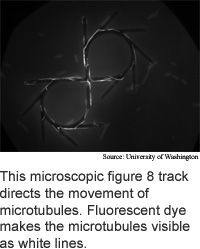
Junctions expand nano railroads
Living cells contain tiny transport systems
made from a pair of proteins -- microtubules and kinesin -- that act much
like railroad tracks and railroad cars.
Researchers from the University of Washington and Sandia National
Laboratories have co-opted the proteins for use in track networks that
can be integrated into nanotechnology devices to shuttle tiny amounts
of materials around. Their latest research covers how to use junctions
in the networks.
The researchers coated tiny synthetic tracks with the motor molecule
kinesin and coaxed microtubules to glide across the kinesin surface. This
is different from the way the proteins work in cells, where kinesin glides
across microtubule tracks.
The researchers worked out how the microtubules move across junctions,
and found ways to use different types of junctions to sort and concentrate
materials. The modified cell-transport proteins could eventually be used
to transport materials around labs-on-a-chip. Using motor proteins like
kinesin rather than diffusion to move materials promises to speed transport
by several orders of magnitude, according to the researchers.
The researchers' next step is to find ways to target biological
and synthetic molecules, binding them to the molecular shuttles and deliver
the cargo to specific destinations.
Microtubule networks could be used in practical applications and
five to ten years, according to the researchers. The work appeared in
the February 27, 2004 issue of Lab on a Chip.
Solar crystals get 2-for-1
Shape-shifting remakes interfaces
Evolution trains robot teams
Group dynamics play out in VR
Briefs:
Nanotube sparks could cool chips
Nanotube makes metal transistor
Junctions expand nano railroad
Indexes bolster ebook search
Microchannel folds fluids
Electricity turns plastic green

Research Watch blog
View from the High Ground Q&A
How It Works
RSS Feeds:
News
Ad links:
Buy an ad link
Ad links: Clear History
Buy an ad link
|
TRN
Newswire and Headline Feeds for Web sites
|
© Copyright Technology Research News, LLC 2000-2010. All rights reserved.